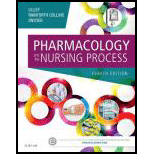
To describe:
The functions of the sympathetic nervous system and the specific effects of adrenergic stimulation.
Concept Introduction:
The central nervous system (CNS) and peripheral nervous system (PNS) are considered as the two important branches of the nervous system. The CNS consists of the spinal cord and brain, whereas the PNS contains autonomic (ANS) and somatic nervous system (SNS). The ANS is further divided into the sympathetic or adrenergic and parasympathetic or cholinergic. It is more important to understand the action of many drugs in these systems. Adrenergic or sympathetic compounds include the substances which are related to the body’s natural substances (endogenous) and synthetic substances (exogenous).
Explanation of Solution
Functions of the sympathetic nervous system:
Adrenergic compounds are involved in the therapeutic effects with the help of their receptors. It stimulates the SNS and it is called as adrenergic agonists. It is also known as sympathomimetic because it mimics the SNS neurotransmitters effects such as norepinephrine, dopamine, and epinephrine. These neurotransmitters are classified in terms of chemical nature as catecholamines. The G-protein coupled adrenergic receptors are targets the catecholamines neurotransmitters such as epinephrine (adrenaline) and norepinephrine (noradrenaline). These adrenergic receptors of the SNS provide the check and balance system to maintain the body homeostasis.
Specific effects of adrenergic stimulation:
It involves the flight or fight responses to acute stress and it is activated due to the unexpected release of hormones. It is also involved in the pupil widening, blood flow diverting from organs to the skeletal muscle.
Thus, the functions and specific effects of adrenergic compounds of the SNS involves the body homeostasis and stimulates the fight or flight responses.
Want to see more full solutions like this?
Chapter 18 Solutions
Pharmacology and the Nursing Process, 8e
 Phlebotomy EssentialsNursingISBN:9781451194524Author:Ruth McCall, Cathee M. Tankersley MT(ASCP)Publisher:JONES+BARTLETT PUBLISHERS, INC.
Phlebotomy EssentialsNursingISBN:9781451194524Author:Ruth McCall, Cathee M. Tankersley MT(ASCP)Publisher:JONES+BARTLETT PUBLISHERS, INC. Gould's Pathophysiology for the Health Profession...NursingISBN:9780323414425Author:Robert J Hubert BSPublisher:Saunders
Gould's Pathophysiology for the Health Profession...NursingISBN:9780323414425Author:Robert J Hubert BSPublisher:Saunders Fundamentals Of NursingNursingISBN:9781496362179Author:Taylor, Carol (carol R.), LYNN, Pamela (pamela Barbara), Bartlett, Jennifer L.Publisher:Wolters Kluwer,
Fundamentals Of NursingNursingISBN:9781496362179Author:Taylor, Carol (carol R.), LYNN, Pamela (pamela Barbara), Bartlett, Jennifer L.Publisher:Wolters Kluwer, Fundamentals of Nursing, 9eNursingISBN:9780323327404Author:Patricia A. Potter RN MSN PhD FAAN, Anne Griffin Perry RN EdD FAAN, Patricia Stockert RN BSN MS PhD, Amy Hall RN BSN MS PhD CNEPublisher:Elsevier Science
Fundamentals of Nursing, 9eNursingISBN:9780323327404Author:Patricia A. Potter RN MSN PhD FAAN, Anne Griffin Perry RN EdD FAAN, Patricia Stockert RN BSN MS PhD, Amy Hall RN BSN MS PhD CNEPublisher:Elsevier Science Study Guide for Gould's Pathophysiology for the H...NursingISBN:9780323414142Author:Hubert BS, Robert J; VanMeter PhD, Karin C.Publisher:Saunders
Study Guide for Gould's Pathophysiology for the H...NursingISBN:9780323414142Author:Hubert BS, Robert J; VanMeter PhD, Karin C.Publisher:Saunders Issues and Ethics in the Helping Professions (Min...NursingISBN:9781337406291Author:Gerald Corey, Marianne Schneider Corey, Cindy CoreyPublisher:Cengage Learning
Issues and Ethics in the Helping Professions (Min...NursingISBN:9781337406291Author:Gerald Corey, Marianne Schneider Corey, Cindy CoreyPublisher:Cengage Learning





